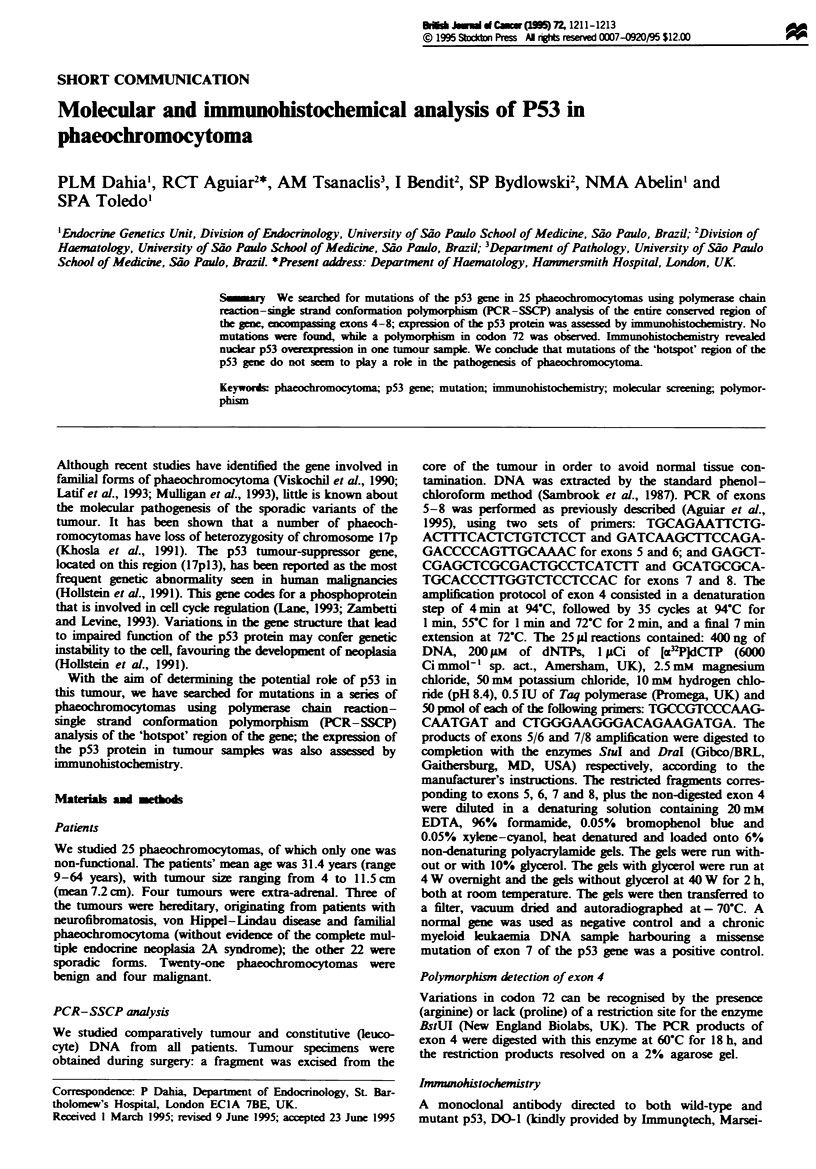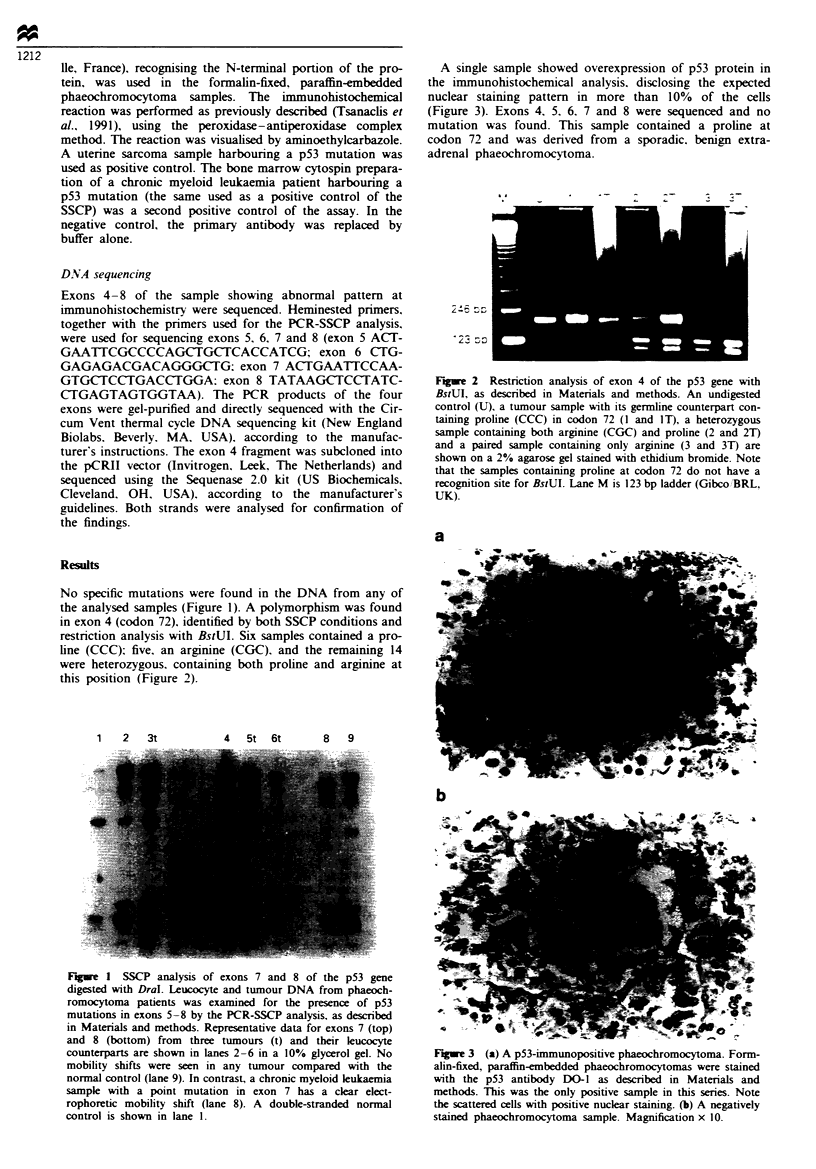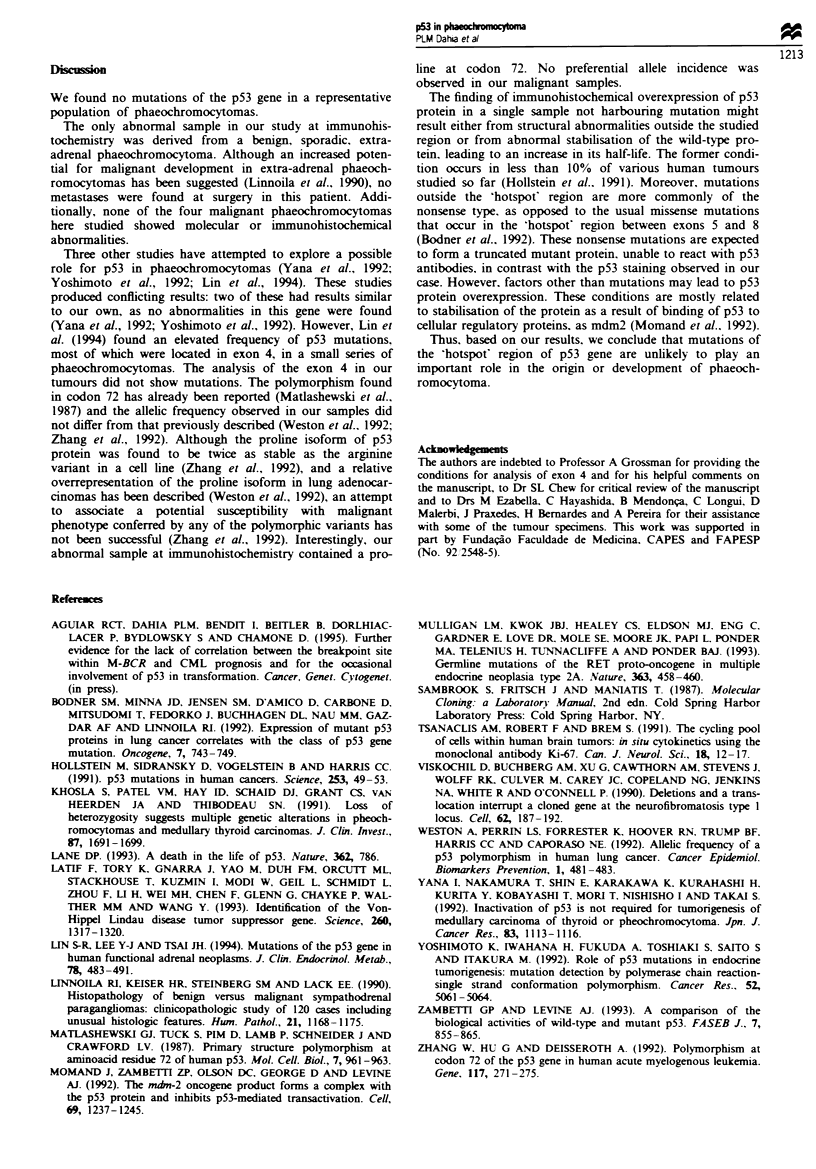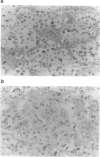Abstract
We searched for mutations of the p53 gene in 25 phaeochromocytomas using polymerase chain reaction-single strand conformation polymorphism (PCR-SSCP) analysis of the entire conserved region of the gene, encompassing exons 4-8; expression of the p53 protein was assessed by immunohistochemistry. No mutations were found, while a polymorphism in codon 72 was observed. Immunohistochemistry revealed nuclear p53 overexpression in one tumour sample. We conclude that mutations of the 'hotspot' region of the p53 gene do not seem to play a role in the pathogenesis of phaeochromocytoma.
Full text
PDF


Images in this article
Selected References
These references are in PubMed. This may not be the complete list of references from this article.
- Bodner S. M., Minna J. D., Jensen S. M., D'Amico D., Carbone D., Mitsudomi T., Fedorko J., Buchhagen D. L., Nau M. M., Gazdar A. F. Expression of mutant p53 proteins in lung cancer correlates with the class of p53 gene mutation. Oncogene. 1992 Apr;7(4):743–749. [PubMed] [Google Scholar]
- Hollstein M., Sidransky D., Vogelstein B., Harris C. C. p53 mutations in human cancers. Science. 1991 Jul 5;253(5015):49–53. doi: 10.1126/science.1905840. [DOI] [PubMed] [Google Scholar]
- Khosla S., Patel V. M., Hay I. D., Schaid D. J., Grant C. S., van Heerden J. A., Thibodeau S. N. Loss of heterozygosity suggests multiple genetic alterations in pheochromocytomas and medullary thyroid carcinomas. J Clin Invest. 1991 May;87(5):1691–1699. doi: 10.1172/JCI115186. [DOI] [PMC free article] [PubMed] [Google Scholar]
- Latif F., Tory K., Gnarra J., Yao M., Duh F. M., Orcutt M. L., Stackhouse T., Kuzmin I., Modi W., Geil L. Identification of the von Hippel-Lindau disease tumor suppressor gene. Science. 1993 May 28;260(5112):1317–1320. doi: 10.1126/science.8493574. [DOI] [PubMed] [Google Scholar]
- Lin S. R., Lee Y. J., Tsai J. H. Mutations of the p53 gene in human functional adrenal neoplasms. J Clin Endocrinol Metab. 1994 Feb;78(2):483–491. doi: 10.1210/jcem.78.2.8106638. [DOI] [PubMed] [Google Scholar]
- Linnoila R. I., Keiser H. R., Steinberg S. M., Lack E. E. Histopathology of benign versus malignant sympathoadrenal paragangliomas: clinicopathologic study of 120 cases including unusual histologic features. Hum Pathol. 1990 Nov;21(11):1168–1180. doi: 10.1016/0046-8177(90)90155-x. [DOI] [PubMed] [Google Scholar]
- Momand J., Zambetti G. P., Olson D. C., George D., Levine A. J. The mdm-2 oncogene product forms a complex with the p53 protein and inhibits p53-mediated transactivation. Cell. 1992 Jun 26;69(7):1237–1245. doi: 10.1016/0092-8674(92)90644-r. [DOI] [PubMed] [Google Scholar]
- Mulligan L. M., Kwok J. B., Healey C. S., Elsdon M. J., Eng C., Gardner E., Love D. R., Mole S. E., Moore J. K., Papi L. Germ-line mutations of the RET proto-oncogene in multiple endocrine neoplasia type 2A. Nature. 1993 Jun 3;363(6428):458–460. doi: 10.1038/363458a0. [DOI] [PubMed] [Google Scholar]
- Tsanaclis A. M., Robert F., Michaud J., Brem S. The cycling pool of cells within human brain tumors: in situ cytokinetics using the monoclonal antibody Ki-67. Can J Neurol Sci. 1991 Feb;18(1):12–17. doi: 10.1017/s0317167100031243. [DOI] [PubMed] [Google Scholar]
- Viskochil D., Buchberg A. M., Xu G., Cawthon R. M., Stevens J., Wolff R. K., Culver M., Carey J. C., Copeland N. G., Jenkins N. A. Deletions and a translocation interrupt a cloned gene at the neurofibromatosis type 1 locus. Cell. 1990 Jul 13;62(1):187–192. doi: 10.1016/0092-8674(90)90252-a. [DOI] [PubMed] [Google Scholar]
- Weston A., Perrin L. S., Forrester K., Hoover R. N., Trump B. F., Harris C. C., Caporaso N. E. Allelic frequency of a p53 polymorphism in human lung cancer. Cancer Epidemiol Biomarkers Prev. 1992 Sep-Oct;1(6):481–483. [PubMed] [Google Scholar]
- Yana I., Nakamura T., Shin E., Karakawa K., Kurahashi H., Kurita Y., Kobayashi T., Mori T., Nishisho I., Takai S. Inactivation of the p53 gene is not required for tumorigenesis of medullary thyroid carcinoma or pheochromocytoma. Jpn J Cancer Res. 1992 Nov;83(11):1113–1116. doi: 10.1111/j.1349-7006.1992.tb02730.x. [DOI] [PMC free article] [PubMed] [Google Scholar]
- Yoshimoto K., Iwahana H., Fukuda A., Sano T., Saito S., Itakura M. Role of p53 mutations in endocrine tumorigenesis: mutation detection by polymerase chain reaction-single strand conformation polymorphism. Cancer Res. 1992 Sep 15;52(18):5061–5064. [PubMed] [Google Scholar]
- Zambetti G. P., Levine A. J. A comparison of the biological activities of wild-type and mutant p53. FASEB J. 1993 Jul;7(10):855–865. doi: 10.1096/fasebj.7.10.8344485. [DOI] [PubMed] [Google Scholar]
- Zhang W., Hu G., Deisseroth A. Polymorphism at codon 72 of the p53 gene in human acute myelogenous leukemia. Gene. 1992 Aug 15;117(2):271–275. doi: 10.1016/0378-1119(92)90738-b. [DOI] [PubMed] [Google Scholar]





